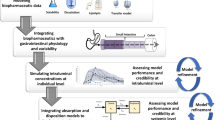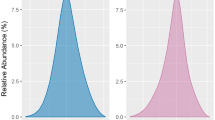Abstract
A pharmacokinetic interpretation of the effects and side-effects of acidic non-steroid anti-inflammatory drugs is presented. It is based on the general principles of drug action and leads to the conclusion that aspirin-like drugs should specifically accumulate and exert pharmacological activity in inflammed tissue, stomach and kidney. Therefore the common effects and side-effects of these drugs may result from unspecific effects in these compartments and might not necessarily be due to specific, i.e., receptor mediated action(s).
Similar content being viewed by others
References
R.L. Miller andR.L. Melmon, in:Clinical Pharmacology, Basic Principles in Therapeutics (Eds K.L. Melmon and H.F. Morrelli; The MacMillan Comp., New York 1972).
H.O. Collier,New Light how Aspirin Works, Nature223, 35 (1969).
M. Weiner andS.J. Pilliero,Nonsteroid Anti-Inflammatory Agents, Ann. Rev. Pharmac.10, 171 (1970).
H.E. Paulus andM.W. Whitehouse,Nonsteroid Anti-Inflammatory Agents, Ann. Rev. Pharmac.13, 107 (1973).
M.W. Whitehouse,Biochemical Properties of Anti-Inflammatory Drugs. II. Uncoupling of Oxidative Phosphorylation in a Connective Tissue (Cartilage) and Liver Michondria by Salicylate Analogues: Relationship of Structure to Activity, Biochem. Pharmac.13, 319 (1964).
M.W. Whitehouse,The Molecular Pharmacology of Anti-Inflammatory Drugs: Some Possible Mechanisms of Action at the Biochemical Level, Biochem. Pharmac. Suppl., p. 293 (1968).
I.F. Skidmore andM.W. Whitehouse,Concerning the Regulation of some Diverse Biochemical Reactions Underlying the Inflammatory Response by Salicylic Acid, Phenylbutazone and other Acidic Anti-Rheumatic Drugs, J. Pharm. Pharmac.18, 558 (1966).
I.F. Skidmore andM.W. Whitehouse,Biochemical Properties of Anti-Inflammatory Drugs, VIII, Biochem. Pharmac.15, 1965 (1966).
N.H. Grant, H.E. Alburn andC. Kryzanauskas,Stabilization of Serum Albumin by Anti-Inflammatory Drugs, Biochem. Pharmac.19, 715 (1970).
L.J. Ignarro,Dissimilar Effects of Anti-Inflammatory Drugs on Stability of Lysosomes from Peritoneal and Circulating Leukocytes and Liver, Biochem. Pharmac.20, 2861 (1971).
P. Phelps andD.J. McCarty,Suppression of Crystal-Induced Synovitis in Canine Joints by Indomethacin. Demonstration of Inhibition of Leucocyte Mobility, Arthritis Rheum.9, 532 (1966).
P. Phelps,PMN Leucocyte Motility in vitro. II. Stimulatory Effects of Monosodium Urate Crystals and Urate in Solution. Partial Inhibition by Colchicine and Indomethacin, Arthritis Rheum.12, 189 (1969).
J.H. Brown, H.K. Mackey andD.A. Riggilo,A Novel in vitro Assay for Anti-Inflammatory Agents Based on Stabilization of Erythrocytes, Proc. Soc. exp. Biol. Med.125, 837 (1967).
M.B. Zucker andJ. Peterson,Inhibition of Adenosine Diphosphate-Induced Secondary Aggregation and other Platelet Functions by Acetylsalicylic Acid Ingestion, Proc. Soc. exp. Biol. Med.127, 547 (1968).
H. Levitan andJ.L. Barker,Effect of Non-Narcotic Analgesics on Membrane Permeability of Molluscan Neurones, Nature New Biol.239, 55 (1972).
J.R. Vane,Inhibition of Prostaglandin Synthesis as a Mechanism of Action for Aspirin-Like Drugs, Nature New Biol.231, 232 (1971).
S.H. Ferreira andJ.R. Vane,New Aspects of the Mode of Action of Nonsteroid Anti-Inflammatory Drugs, Ann. Rev. Pharmac.14, 57 (1974).
R.I. Flower,Drugs which Inhibit Prostaglandin Biosynthesis, Pharmac. Rev.26, 33 (1974).
E.A. Ham, K.J. Cirillo, M. Zanetti, T.Y. Shen andF.A. Kuehl,Studies on the Mode of Action of Non-Steroidal, Anti-Inflammatory Agents, in:Prostaglandins in Cellular Biology (Eds P.W. Ramwell and B.B. Pharriss; Plenum Press, New York 1972), 345 p.
R.E. Lee,The Influence of Psychotropic Drugs on Prostaglandin Biosynthesis, Prostaglandins5, 63 (1974).
H. Kunze, E. Bohn andW. Vogt,Effects of Various Local Anaesthetics on Prostaglandin Biosynthesis in vitro, Naunyn-Schmiedebergs Arch. Pharmak. Suppl. 285, R49 (1974).
D.M. Woodbury,Analgesic-Antipyretics, Anti-Inflammatory Agents and Inhibitors of Uric Acid Synthesis, in:The Pharmacological Basis of Therapeutics, 4th ed. (Eds. L.S. Goodman and A. Gilman; Macmillan, New York 1970), 341 p.
A. Goldstein, L. Aronow andS.M. Kalman,Principles of Drug Action (Harper and Row, New York 1969).
N.A. Cummings andG.L. Nordby,Measurement of Synovial Fluid pH in Normal and Arthritic Knees, Arthritis Rheum.9, 47 (1966).
D.J. McCarty, Jr., P. Phelps andJ. Pyenson,Crystal-Induced Inflammation in Canine Joints. I. An Experimental Model with Quantification of the Host Response, J. exp. Med.99, 124 (1966).
D.J.B. St. John andF.T. McDermitt,Influence of Achylorhydria on Aspirin-Induced Blood Loss, Br. med. J.II, 450 (1970).
J.R. Leonards andG. Levy,Reduction or Prevention of Aspirin-Induced Occult Gastro-Intestinal Blood Loss in Man, Clin. Pharmac. Ther.10, 571 (1969).
C.A.M. Hogben, D.J. Tocco, B.B. Brodie andL.S. Schanker,On the Mechanism of Intestinal Absorption of Drugs, J. Pharmac. exp. Ther.125, 275 (1959).
G. Wilhelmi andR. Pulver,Untersuchungen zur Frage eines peripheren Angriffspunktes der Pyrazole bei der antiphlogistischen Wirkung, Drug Res.5, 221 (1955).
A. Benakis, G. Tsoukas andB. Glasson,Localization of Butylmalonic Acid-mono-(1,2-diphenylhydrazide)-calcium-14 C (Bumadizone-calcium), a New Anti-Inflammatory Drug, in Rats and Mice with Whole-Body Autoradiography. Specific Localization in the Carragenine-Inflamed Paw and in General Experimental Polyarthritic Rats, Drug. Res.23, 1231 (1973).
T.J. Williams andJ. Morley,Measurement of Rate of Extravasation of Plasma Protein in Inflammatory Responses in Guinea-Pig Skin Using a Continuous Recording Method, Br. J. exp. Pathol.55, 1 (1974).
Author information
Authors and Affiliations
Rights and permissions
About this article
Cite this article
Brune, K. How aspirin might work: A pharmacokinetic approach. Agents and Actions 43, 218–220 (1994). https://doi.org/10.1007/BF01986692
Received:
Issue Date:
DOI: https://doi.org/10.1007/BF01986692




